😻AP BIO Chapter 21 - The Evolution of Populations
Overview
21.1 Genetic variation makes evolution possible
21.2 The Hardy-Weinberg equation can be used to test whether a population is evolving
21.3 Natural selection, genetic drift, and gene flow can alter allele frequencies in a population
21.4 Natural selection is the only mechanism that consistently causes adaptive evolution
BIG IDEAS: Genetic variation within a population makes natural selection and evolution possible. Mathematics can be used to calculate changes (Big Idea 1) and the distribution of genes or alleles (Big Idea 3) within a population. As populations evolve, so do their interactions with other populations (Big Idea 4) and the maintenance of their dynamic homeostasis (Big Idea 2)
Natural selection occurs with ___; evolution can only happen with _
- individuals; a population
Evidence of selection by food source - The data represent adult beak depth measurements of medium ground finches hatched in the generations before and after the 1977 drought. In a single generation, evolution by natural selection resulted in a larger average beak size in the population
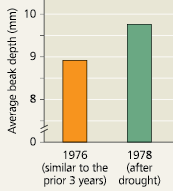
{{Microevolution:{{
Evolutionary change below the species level; change in the allele frequencies in a population over generations
What are the three main mechanisms to cause a change in allele frequencies?
Natural selection, genetic drift, and gene flow
{{Natural Selection:{{
Phenotypes that increase the fitness of organisms will be amplified over generations
{{Genetic Drift:{{
Chance events that alter allele frequencies
{{Gene Flow:{{
The transfer of alleles between populations
Natural selection and adaptation cannot occur without genetic ___
- variation
What’s the ultimate source of genetic variation?
Mutations
List sources of genetic variation
Mutations, genetic recombination, genetic drift, meiosis errors (unequal crossing over), slippage during DNA replication, transposable elements
%%21.1 - Genetic variation makes evolution possible%%
Genetic variation refers to genetic differences among individuals within a population
The nucleotide differences that provide the basis of genetic variation originate when mutation and gene duplication produce new alleles and new genes
New genetic variants are produced rapidly in organisms with short generation times. In sexually reproducing organisms, most of the genetic differences among individuals result from crossing over, the independent assortment of chromosomes, and fertilization
{{Genetic Variation:{{
The difference in DNA among individuals or populations
Phenotypic variation in horses - In horses, coat color varies along a continuum and is influenced by multiple genes
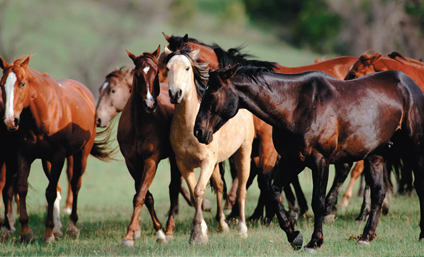
Explain how the “either-or“ basis and continuum relate to phenotypic differences
Either-or characters are typically determined by a single gene locus, with different alleles producing distinct phenotypes. Variation from a continuum usually results from the influence of two or more genes on a single phenotypic character
Why doesn’t all variation at the molecular level of DNA result in phenotypic variation?
The variation may lie in noncoding introns. Also, a different DNA sequence can still lead to the same amino acid sequence
Extensive genetic variation at the molecular level - This diagram summarizes data from a study comparing the DNA sequence of the alcohol dehydrogenase (Adh) gene in several fruit flies (Drosophila melanogaster). The Adh gene has four exons (dark blue) separated by introns (light blue); the exons include the coding regions that are ultimately translated into the amino acids of the Adh enzyme. Only one substitution has a phenotypic effect, producing a different form of the Adh enzyme

Explain how a base-pair substitution that alters a coding region of the Adh locus could have no effect on amino acid sequence. Then explain how an insertion in an exon could have no effect on the protein produced
The genetic code is redundant, meaning that more than one codon can specify the same amino acid. As a result, a substitution at a particular site in a coding region of the Adh gene might change the codon but not the translated amino acid, and thus not the resulting protein encoded by the gene. One way an insertion in an exon would not affect the gene produced is if it occurs in an untranslated region of the exon. This is the case for the insertion at location 1,703
What two factors lead to phenotype
Inherited genotype and environmental influences
Nonheritable variation - These caterpillars of the moth Nemoria arizonaria owe their different appearances to chemicals in their diets, not to differences in their genotypes. (a) Caterpillars raised on a diet of oak flowers resemble the flowers, whereas (b) their siblings raised on oak leaves resemble oak twigs

{{Mutation:{{
A change in the nucleotide sequence of an organism’s DNA
{{Neutral Variation:{{
Genetic variation that does not provide a selective advantage or disadvantage
Chromosomal changes that delete, disrupt, or rearrange many loci are usually ___
- harmful
How does sexual reproduction shuffle alleles to make random individual genotypes?
Crossing over, independent assortment, and random fertilization
Crossing Over
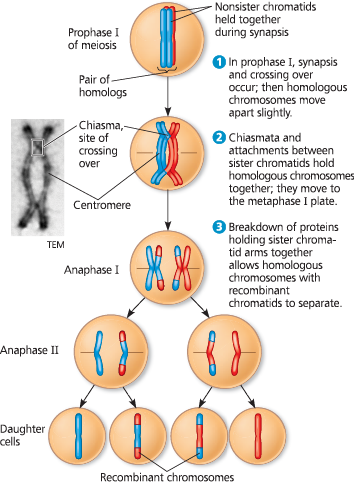
Independent Assortment

%%Explain why genetic variation within a population is a prerequisite for evolution%%
Within a population, genetic differences among individuals provide the raw material on which natural selection and other mechanisms can act. Without such differences, allele frequencies could not change over time—and hence the population could not evolve
%%Of all the mutations that occur in a population, why do only a small fraction become widespread?%%
Many mutations occur in somatic cells, which do not produce gametes and so are lost when the organism dies. Of mutations that do occur in cell lines that produce gametes, many do not have a phenotypic effect on which natural selection can act. Others have a harmful effect and are thus unlikely to increase in frequency because they decrease the reproductive success of their bearers
%%If a population stopped reproducing sexually (but still reproduced asexually), how would its genetic variation be affected over time?%%
Its genetic variation (whether measured at the level of the gene or at the level of nucleotide sequences) would probably drop over time. During meiosis, crossing over and the independent assortment of chromosomes produce many new combinations of alleles. In addition, a population contains a vast number of possible mating combinations, and fertilization brings together the gametes of individuals with different genetic backgrounds. Thus, via crossing over, independent assortment of chromosomes, and fertilization, sexual reproduction reshuffles alleles into fresh combinations each generation. Without sexual reproduction, the rate of forming new combinations of alleles would be vastly reduced, causing the overall amount of genetic variation to drop
%%Typically, most of the nucleotide variability that occurs within a genetic locus does not affect the phenotype. Explain why%%
Much of the nucleotide variability at a genetic locus occurs within introns. Nucleotide variation at these sites typically does not affect the phenotype because introns do not code for the protein product of the gene. (Note: In certain circumstances, it is possible that a change in an intron could affect RNA splicing and ultimately have some phenotypic effect on the organism, but such mechanisms are not covered in this introductory text.) There are also many variable nucleotide sites within exons. However, most of the variable sites within exons reflect changes to the DNA sequence that do not change the sequence of amino acids encoded by the gene (and hence may not affect the phenotype)
%%21.2 - The Hardy-Weinberg equation can be used to test whether a population is evolving%%
A population, a localized group of organisms belonging to one species, is united by its gene pool, the aggregate of all the alleles in the population
For a population in Hardy-Weinberg equilibrium, the allele and genotype frequencies will remain constant if the population is large, mating is random, mutation is negligible, there is no gene flow, and there is no natural selection. For such a population, if p and q represent the frequencies of the only two possible alleles at a particular locus, then p2 is the frequency of one kind of homozygote, q2 is the frequency of the other kind of homozygote, and 2pq is the frequency of the heterozygous genotype
{{Population:{{
A group of individuals of the same species that live in the same area and interbreed, producing fertile offspring
One species, two populations - These two caribou populations in the Yukon are not totally isolated; they sometimes share the same area. Still, members of either population are most likely to breed within their own population
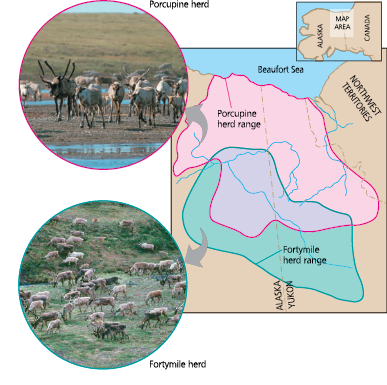
{{Gene Pool:{{
The aggregate of all copies of every type of allele at all loci in every individual in a population. The term is also used in a more restricted sense as the aggregate of alleles for just one or a few loci in a population
If only one allele exists for a particular locus in a population, that allele is said to be ___ in the gene pool, and all individuals are homozygous for that allele
- fixed
{{Hardy-Weinberg Equilibrium:{{
The state of a population in which frequencies of alleles and genotypes remain constant from generation to generation provided that only Mendelian segregation and recombination of alleles are at work
Instead of considering the possible allele combinations from one cross, we’ll consider the combination of alleles in ___ of the crosses in a population
- all
Selecting alleles at random from a gene pool
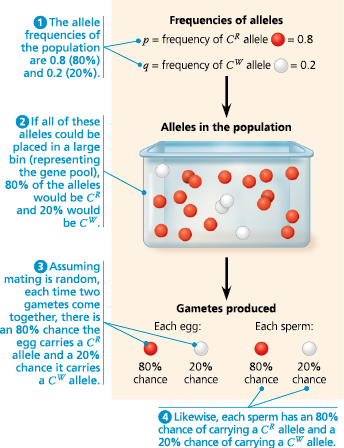
If allele C^R has a frequency of .8 and C^W has a frequency of .2, what’s the frequency of heterozygotes?
If the sperm provides the C R allele and the egg provides the C W allele, the resulting heterozygotes will be p × q = 0.8 × 0.2 = 0.16, or 16% of the total. If the sperm provides the C W allele and the egg the C R allele, the heterozygous offspring will make up q × p = 0.2 × 0.8 = 0.16, or 16%. The frequency of heterozygotes is thus the sum of these possibilities: pq + qp = 2pq = 0.16 + 0.16 = 0.32, or 32%
Thus, the equation for Hardy-Weinberg equilibrium states that at a locus with two alleles, the three genotypes will appear in the following proportions:

Hardy-Weinbrg Equilibrium - In our wildflower population, the gene pool remains constant from one generation to the next. Mendelian processes alone do not alter frequencies of alleles or genotypes
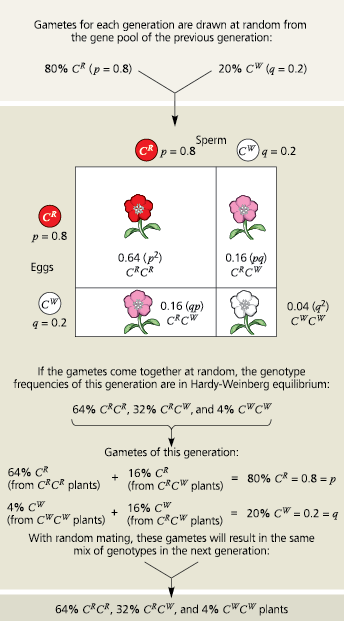
%%If the frequency of the CR allele is 0.6, predict the frequencies of the CRCR, CRCW, and CWCW genotypes%%
The predicted frequencies are 36% C RC R, 48% C RC W, and 16% C WC W
What are the five condition of the equilibrium?
No mutations, random mating, no natural selection, extremely large population size, and no gene flow
No mutations -
The gene pool is modified if mutations alter alleles or if entire genes are deleted or duplicated
Random mating -
If individuals tend to mate within a subset of the population, such as their near neighbors or close relatives (inbreeding), random mixing of gametes does not occur, and genotype frequencies change
No natural selection -
Allele frequencies can change when individuals with different genotypes differ in their survival or reproductive success
Extreme large population size -
The smaller the population, the more likely it is that allele frequencies will fluctuate by chance from one generation to the next (a process called genetic drift)
No gene flow -
By moving alleles into or out of populations, gene flow can alter allele frequencies
The assumption of Hardy-Weinberg equilibrium yields an ___; the real number of carriers may _
- approximation; differ
%%A population has 700 individuals, 85 of genotype AA, 320 of genotype Aa, and 295 of genotype aa. What are the frequencies of alleles A and a?%%
Each individual has two alleles, so the total number of alleles is 1,400. To calculate the frequency of allele A, note that each of the 85 individuals of genotype AA has two A alleles, each of the 320 individuals of genotype Aa has oneA allele, and each of the 295 individuals of genotype aa has zero A alleles. Thus, the frequency (p) of allele A is [ (2*85) + (1*320) + (0*295) ] / 1,400 = 0.35. There are only two alleles (A and a) in our population, so the frequency of allele a must be q = 1 – p = 0.65
%%The frequency of allele a is 0.45 for a population in Hardy-Weinberg equilibrium. What are the expected frequencies of genotypes AA, Aa, and aa?%%
Because the frequency of allele a is 0.45, the frequency of allele A must be 0.55. Thus, the expected genotype frequencies are p2 = 0.3025 for genotype AA, 2pq = 0.495 for genotype Aa, and q2 = 0.2025 for genotype aa
%%A locus that affects susceptibility to a degenerative brain disease has two alleles, V and v. In a population, 16 people have genotype VV, 92 have genotype Vv, and 12 have genotype vv. Is this population evolving? Explain%%
There are 120 individuals in the population, so there are 240 alleles. Of these, there are 124 V alleles—32 from the 16 VV individuals and 92 from the 92 Vv individuals. Thus, the frequency of the V allele is p = 124/240 = 0.52; hence, the frequency of the v allele is q = 0.48. Based on the Hardy-Weinberg equation, if the population were not evolving, the frequency of genotype VV should be p2 = 0.52 × 0.52 = 0.27; the frequency of genotype Vv should be 2pq = 2 × 0.52 × 0.48 = 0.5; and the frequency of genotype vv should be q2 = 0.48 × 0.48 = 0.23. In a population of 120 individuals, these expected genotype frequencies lead us to predict that there would be 32 VV individuals (0.27 × 120), 60 Vv individuals (0.5 × 120), and 28 vv individuals (0.23 × 120). The actual numbers for the population (16 VV, 92 Vv, 12 vv) deviate from these expectations (fewer homozygotes and more heterozygotes than expected). This indicates that the population is not in Hardy-Weinberg equilibrium and hence may be evolving at this locus
%%Is it circular reasoning to calculate p and q from observed genotype frequencies and then use those values of p and q to test whether the population is in Hardy-Weinberg equilibrium? Explain your answer. (Hint: Consider a specific case, such as a population with 195 individuals of genotype AA, 10 of genotype Aa, and 195 of genotype aa.)%%
No, this is not an example of circular reasoning. Calculating p and q from observed genotype frequencies does not imply that those genotype frequencies must be in Hardy-Weinberg equilibrium. For example, consider a population that has 195 individuals of genotype AA, 10 of genotype Aa, and 195 of genotype aa. Calculating p and q from these values yields p = q = 0.5. Using the Hardy-Weinberg equation, the predicted equilibrium frequencies are p2 = 0.25 for genotype AA, 2pq = 0.5 for genotype Aa, and q2 = 0.25 for genotype aa. Since there are 400 individuals in the population, these predicted genotype frequencies indicate that there should be 100 AA individuals, 200 Aa individuals, and 100 aa individuals—numbers that differ greatly from the values that we used to calculate p and q
%%21.3 - Natural selection, genetic drift, and gene flow can alter allele frequencies in a population%%
In natural selection, individuals that have certain inherited traits tend to survive and reproduce at higher rates than other individuals because of those traits
In genetic drift, chance fluctuations in allele frequencies over generations tend to reduce genetic variation
Gene flow, the transfer of alleles between populations, tends to reduce genetic differences between populations over time
Individuals in a population exhibit variations in their heritable traits, and those with traits that are better suited to their environment tend to produce ___ offspring than those with traits that are not as well suited
- more
{{Adaptive Evolution:{{
A process in which traits that enhance survival or reproduction tend to increase in frequency over time
{{Genetic Drift:{{
A process in which chance events cause unpredictable fluctuations in allele frequencies from one generation to the next
Is genetic drift more pronounced in small or large populations?
small
Genetic drift - This small wildflower population has a stable size of ten plants. Suppose that by chance only five plants of generation 1 (those highlighted in yellow) produce fertile offspring. (This could occur, for example, if only those plants happened to grow in a location that provided enough nutrients to support the production of offspring.) Again by chance, only two plants of generation 2 leave fertile offspring. As a result, by chance the frequency of the C W allele first increases in generation 2 and then falls to zero in generation 3
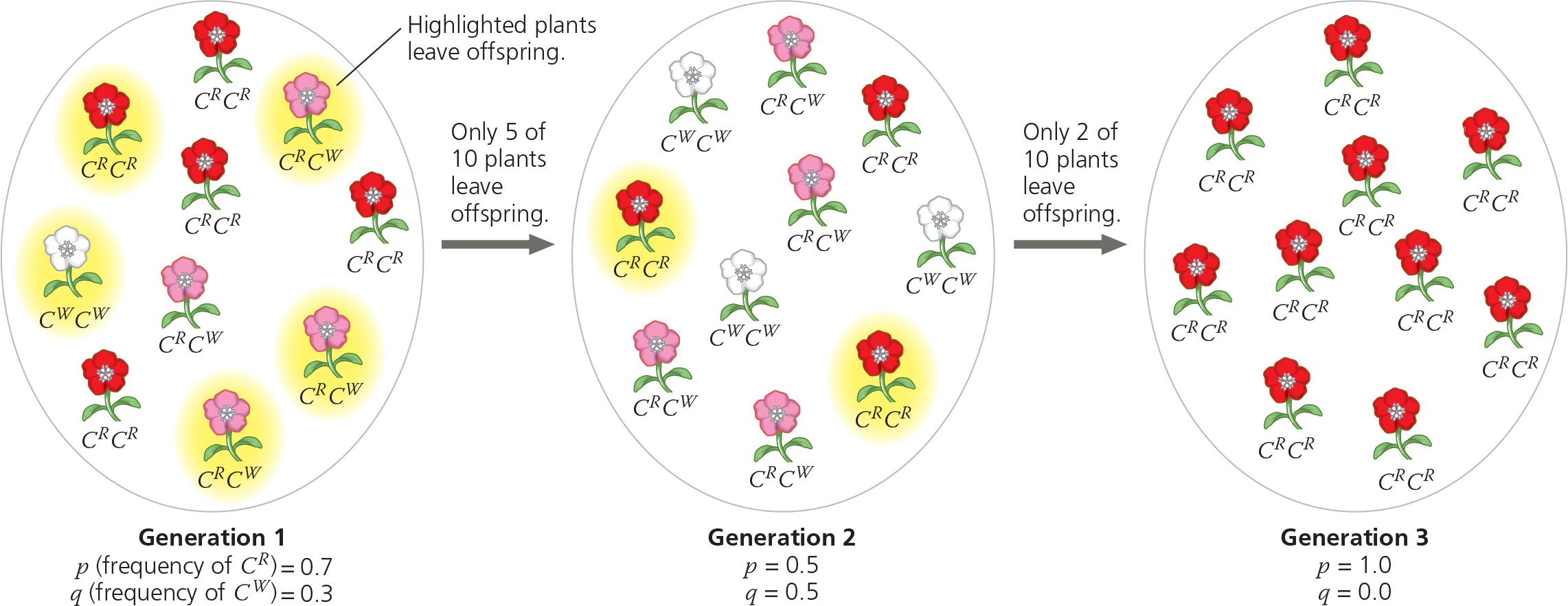
{{Founder Effect:{{
Genetic drift that occurs when a few individuals become isolated from a larger population and form a new population whose gene pool composition is not reflective of that of the original population
The founder effect
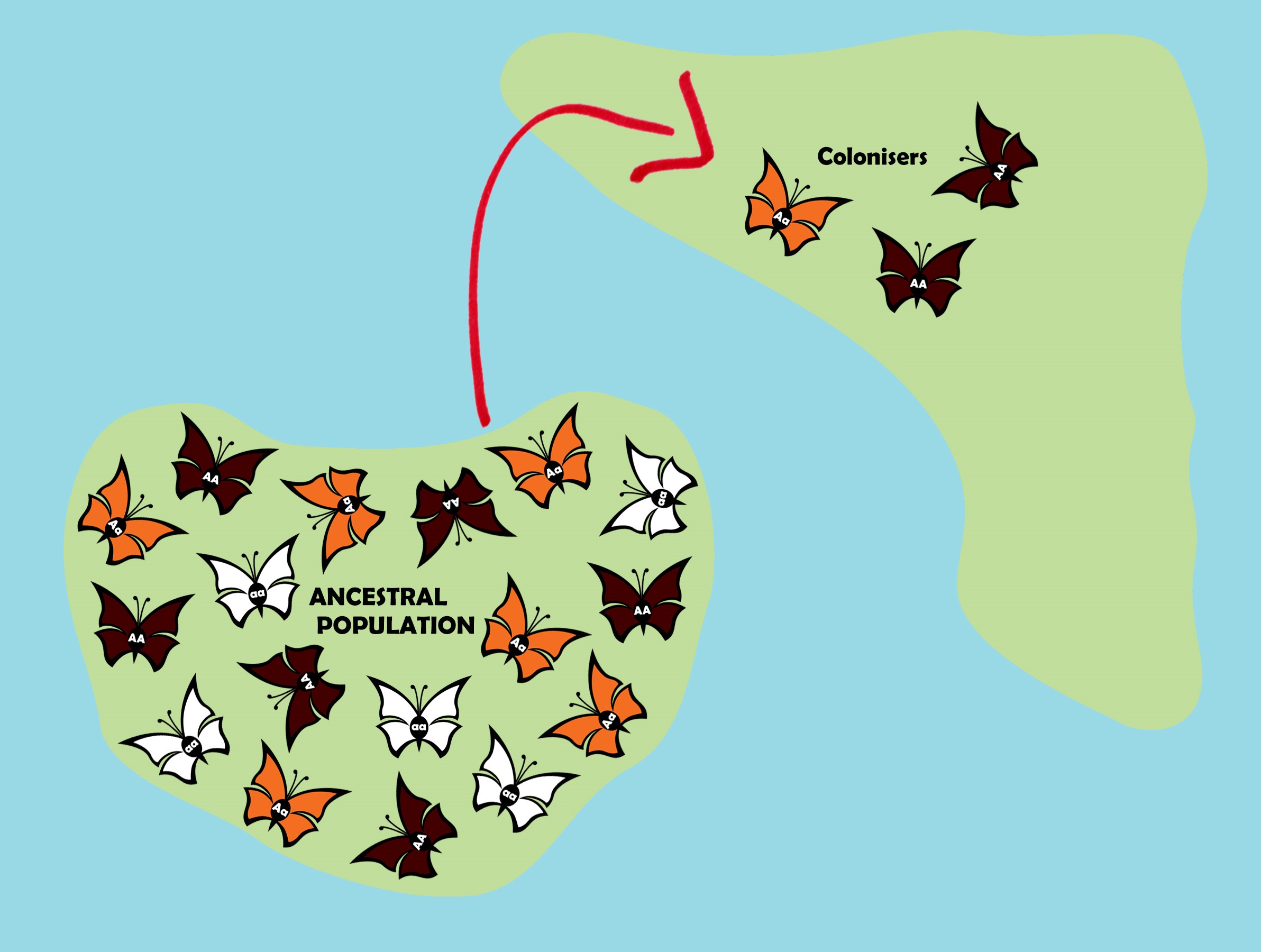
{{Bottleneck Effect:{{
Genetic drift that occurs when the size of a population is reduced, as by a natural disaster or human action. Typically, the surviving population is no longer genetically representative of the original population
The bottleneck effect
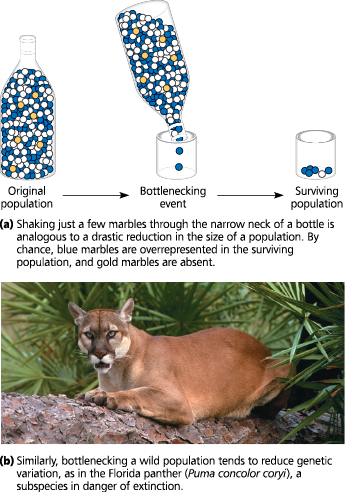
Human actions sometimes create severe ___ for other species
- bottlenecks
Genetic drift and loss of genetic variation
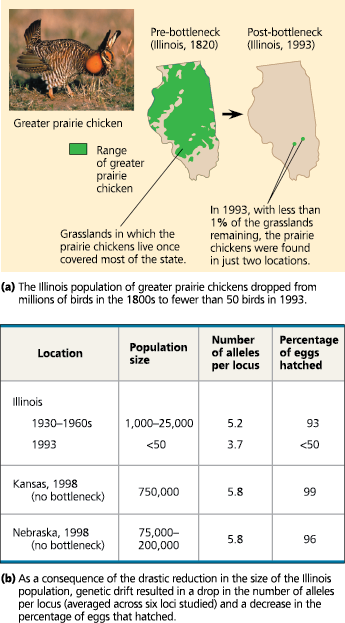
Summarize the effects and causes of genetic drift
Genetic drift is significant in small populations, can cause allele frequencies to change at random, can lead to a loss of genetic variation within a population, and can cause harmful alleles to become fixed
Natural selection leads to ___ evolutionary change while genetic drift is _
- consistent; unpredictable
Effects of genetic drift - A summary
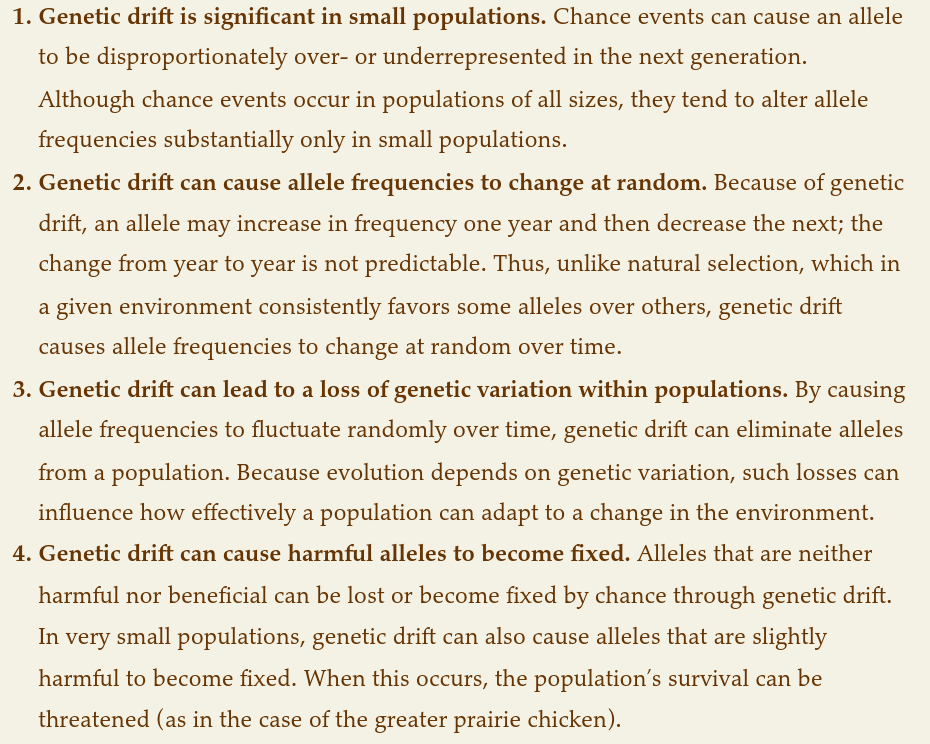
{{Gene Flow:{{
The transfer of alleles from one population to another, resulting from the movement of fertile individuals or their gametes
How does immigration and emigration impact gene flow?
When new members (and their genes) enter a population, the overall balance of the gene pool is changed 
Gene flow and local adaption - In Parus major populations on Vlieland, the yearly survival rate of females born in the central population is lower than that of females born in the eastern population. Gene flow from the mainland is much higher to the central population than it is to the eastern population, and birds from the mainland are selected against in both populations. These data suggest that gene flow from the mainland has prevented the central population from adapting fully to its local conditions
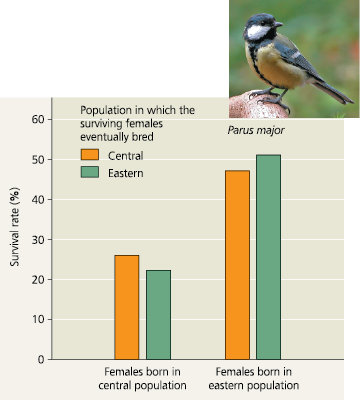
As newly born organisms in a population have more immigrant genes, it can ___ the degree to which members of that population are adapted to their lives in their environment
- reduce (if a population is already fairly adapted to an environment, new characters disrupt the other traits)
As more immigrant genes are introduced to a population, it can increase genetic variety which ___ the ability to adapt to local conditions
- improves (if a population isn’t very adapted t an environment, this provides more variety for natural selection to act on)
As a result of genetic drift in humans, ___ alleles are exchanged are there are _ genetic differences between populations that previously had very little contact
- more; fewer
%%In what sense is natural selection more “predictable” than genetic drift?%%
Natural selection is more “predictable” in that it alters allele frequencies in a nonrandom way: It tends to increase the frequency of alleles that increase the organism’s reproductive success in its environment and decrease the frequency of alleles that decrease the organism’s reproductive success. Alleles subject to genetic drift increase or decrease in frequency by chance alone, whether or not they are advantageous
%%Distinguish genetic drift from gene flow in terms of (a) how they occur and (b) their implications for future genetic variation in a population%%
Genetic drift results from chance events that cause allele frequencies to fluctuate at random from generation to generation; within a population, this process tends to decrease genetic variation over time. Gene flow is the transfer of alleles between populations, a process that can introduce new alleles to a population and hence may increase its genetic variation (albeit slightly, since rates of gene flow are often low)
%%Suppose two plant populations exchange pollen and seeds. In one population, individuals of genotype AA are most common (9,000 AA, 900 Aa, 100 aa), while the opposite is true in the other population (100 AA, 900 Aa, 9,000 aa). If neither allele has a selective advantage, what will happen over time to the allele and genotype frequencies of these populations?%%
Selection is not important at this locus; furthermore, the populations are not small, and hence the effects of genetic drift should not be pronounced. Gene flow is occurring via the movement of pollen and seeds. Thus, allele and genotype frequencies in these populations should become more similar over time as a result of gene flow
%%Would two small, geographically isolated populations in very different environments be likely to evolve in similar ways?%%
It is unlikely that two such populations would evolve in similar ways. Since their environments are very different, the alleles favored by natural selection would probably differ between the two populations. Although genetic drift may have important effects in each of these small populations, drift causes unpredictable changes in allele frequencies, so it is unlikely that drift would cause the populations to evolve in similar ways. Both populations are geographically isolated, suggesting that little gene flow would occur between them (again making it less likely that they would evolve in similar ways)
%%21.4 - Natural selection is the only mechanism that consistently causes adaptive evolution%%
One organism has greater relative fitness than another if it leaves more fertile descendants. The modes of natural selection differ in their effect on phenotype (the white arrows in the summary diagram below represent selective pressure on a population)
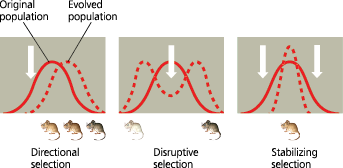
Unlike genetic drift and gene flow, natural selection consistently increases the frequencies of alleles that enhance survival and reproduction, thus improving the degree to which organisms are well-suited for life in their environment
Sexual selection can result in secondary sex characteristics that can give individuals advantages in mating
Balancing selection occurs when natural selection maintains two or more forms in a population
There are constraints to evolution: Natural selection can act only on available variation; structures result from modified ancestral anatomy; adaptations are often compromises; and chance, natural selection, and the environment interact
Because of blending and sorting, natural selection is ___ and _ the frequencies of alleles that provide a reproductive advantage
- not random; consistently increasing
{{Adaptive Evolution:{{
A process in which traits that enhance survival or reproduction tend to increase in frequency in a population over time
{{Relative Fitness:{{
The contribution an individual makes to the gene pool of the next generation, relative to the contributions of other individuals in the population
Modes of selection - These cases describe three ways in which a hypothetical deer mouse population with heritable variation in fur coloration from light to dark might evolve. The graphs show how the frequencies of individuals with different fur colors change over time. The large white arrows symbolize selective pressures against certain phenotypes

{{Directional Selection:{{
Natural selection in which individuals at one end of the phenotypic range survive or reproduce more successfully than other individuals
{{Disruptive Selection:{{
Natural selection in which individuals at both extremes of a phenotypic range survive or reproduce more successfully than do individuals with intermediate phenotypes
{{Stabilizing Selection:{{
Natural selection in which intermediate phenotypes survive or reproduce more successfully than do extreme phenotypes
Movable jaw bones in snakes
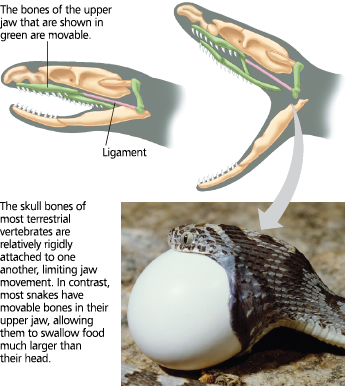
As the proportion of individuals that have favorable traits increases, the degree to which a species is well suited for life in its environment ___; that is, adaptive evolution occurs
- improves
Why is adaptive evolution a continuous, dynamic process?
Physical and biological components of an organism’s environment can change, so the traits with the most fitness change over time
Why aren’t genetic drift and gene flow consistent?
Genetic drift can cause the frequency of a slightly beneficial allele to increase, but it also can cause the frequency of such an allele to decrease. Similarly, gene flow may introduce alleles that are advantageous or ones that are disadvantageous
{{Balancing Selection:{{
Natural selection that maintains two or more phenotypic forms in a population
{{Heterozygote Advantage:{{
Greater reproductive success of heterozygous individuals compared with homozygotes; tends to preserve variation in a gene pool
%%In a region free of malaria, would individuals who are heterozygous for the sickle-cell allele be selected for or selected against?%%
Under prolonged low-oxygen conditions, some of the red blood cells of a heterozygote may sickle, leading to harmful effects. This does not occur in individuals with two wild-type hemoglobin alleles, suggesting that there may be selection against heterozygotes in malaria-free regions (where there is no heterozygote advantage). However, since heterozygotes are healthy under most conditions, selection against them is unlikely to be strong
{{Frequency-Dependent Selection:{{
Selection in which the fitness of a phenotype depends on how common the phenotype is in a population
Frequency-dependent selection - In a population of the scale-eating fish Perissodus microlepis, the frequency of left-mouthed individuals (red data points) rises and falls in a regular manner. The frequency of left-mouthed individuals among adults that reproduced was also recorded in three sample years (green data points)
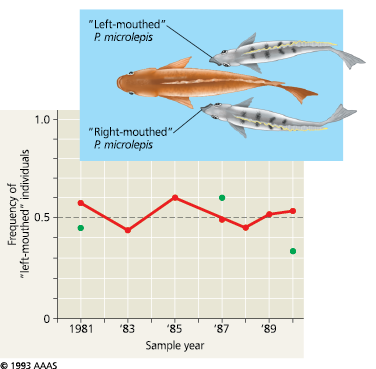
{{Sexual Selection:{{
A process in which individuals with certain inherited characteristics are more likely than other individuals of the same sex to obtain mates
{{Sexual Dimorphism:{{
Differenced between the secondary sex characteristics of males an females of the same species
Sexual dimorphism and sexual selection - Peacocks (left) and peahens (right) show extreme sexual dimorphism. Intrasexual selection between competing males is followed by intersexual selection when the females choose among the showiest males
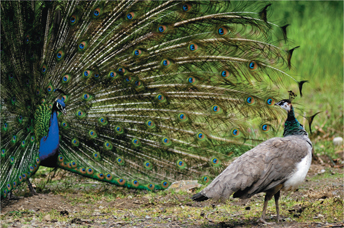
{{Intrasexual Selection:{{
Selection within the same sex; individuals of one sex compete directly for mates of the opposite sex
{{Intersexual Selection (Mate Choice):{{
Individuals of one sex are choosy in selecting their mates from the other sex
Intrasexual selection in commonly in ___ while intersexual selection is typically in _
- males; females
If the trait preferred by females is indicative of a male’s overall genetic quality, both the male trait and female preference for it should ___
- increase in frequency
Experiment 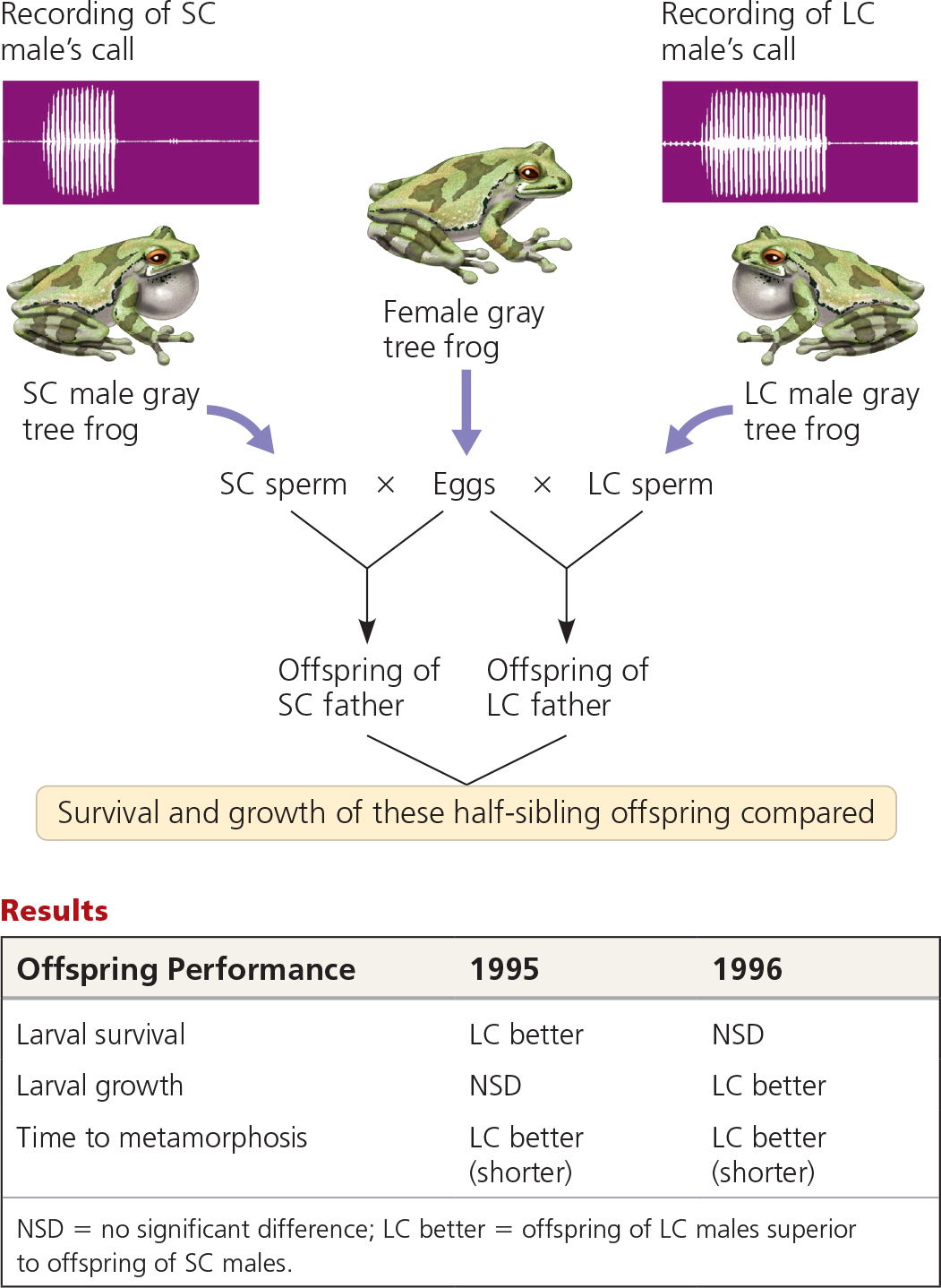
Conclusion - Because offspring fathered by an LC male outperformed their half-siblings fathered by an SC male, the team concluded that the duration of a male’s mating call is indicative of the male’s overall genetic quality. This result supports the hypothesis that female mate choice can be based on a trait that indicates whether the male has “good genes”
%%Why did the researchers split each female frog’s eggs into two batches for fertilization by different males? Why didn’t they mate each female with a single male frog?%%
Crossing a single female’s eggs with both an SC and an LC male’s sperm allowed the researchers to directly compare the effects of the males’ contribution to the next generation since both batches of offspring had the same maternal contribution. This isolation of the male’s impact enabled researchers to draw conclusions about differences in genetic “quality” between the SC and LC males
Why does nature abound with examples of organisms that are less than ideally suited for their lifestyles?
Selection can act only on existing variations, evolution is limited by historical constraints, adaptations are often compromises, and chance and natural selection interact with the environment
New advantageous alleles do not arise
- spontaneously on demand
Evolution operates on the traits that ___ and doesn’t scrap ancestral anatomy to build a new complex
- an organism already has
What are examples of adaptive compromises?
Seals could walk better on rocks with legs but instead have flippers. Humans have agility and versatility, but we are prone to sprains, torn ligaments, and dislocations
Evolutionary compromise - The loud call that enables a Túngara frog to attract mates also attracts more dangerous characters in the neighborhood—in this case, a bat about to seize a meal

If a storm blows insects or birds hundreds of kilometers over an ocean to an island, the wind does not necessarily transport those individuals that are best suited to the new environment. Thus, not all alleles present in the founding population’s gene pool are ___
- best suited to the environment
Natural selection operates on a ___ basis
- better than
%%What is the relative fitness of a sterile mule?%%
Zero, because fitness includes reproductive contribution to the next generation, and a sterile mule cannot produce offspring
%%Explain why natural selection is the only evolutionary mechanism that consistently leads to adaptive evolution%%
Although both gene flow and genetic drift can increase the frequency of advantageous alleles in a population, they can also decrease the frequency of advantageous alleles or increase the frequency of harmful alleles. Only natural selection consistently results in an increase in the frequency of alleles that enhance survival or reproduction. Thus, natural selection is the only mechanism that consistently leads to adaptive evolution
%%Consider a population in which heterozygotes at a certain locus have an extreme phenotype (such as being larger than homozygotes) that confers a selective advantage. Does such a situation represent directional, disruptive, or stabilizing selection?%%
The three modes of natural selection (directional, stabilizing, and disruptive) are defined in terms of the selective advantage of different phenotypes, not different genotypes. Thus, the type of selection represented by heterozygote advantage depends on the phenotype of the heterozygotes. In this question, because heterozygous individuals have a more extreme phenotype than either homozygote, heterozygote advantage represents directional selection
%%How might secondary sex characteristics differ between males and females in a species in which females compete for mates?%%
Compared to males, it is likely that the females of such species would be larger, more colorful, endowed with more elaborate ornamentation (for example, a large morphological feature such as the peacock’s tail), and more apt to engage in behaviors intended to attract mates or prevent other members of their sex from obtaining mates